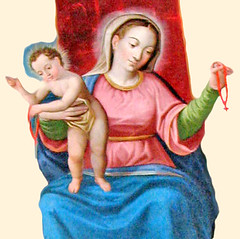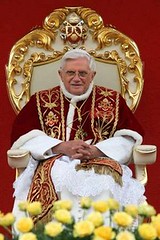The ox and ass and camel, which adore...

There is a beautiful poem by Christina Rossetti which is set to the most sublime music by Harold Darke. It is called "In the bleak mid-winter" and one of my favourite Christmas carols. Now, lest you think I am beginning to mark Christmas even earlier than the Filipinos (who begin in September!!), I merely want to quote this verse:
"Enough for him, whom cherubim worship night and day,
A breastful of milk and a mangerful of hay;
Enough for him, whom angels fall down before,
The ox and ass and camel, which adore."
The last line of that verse came to mind last night as I contemplated today's Memorial in honour of St Antony of Padua. He is probably one of the more popular saints in the sanctoral, his statue is found in most churches and most Catholics would have had recourse to him at some time... He is the patron of lost items! Over the weekend, the frescos of Goya in the San Antonio hermitage in Madrid have been uncovered after a 16 year long restoration. They depict one of the miracles of this saint: the resurrection of an assasinated man. Indeed, St Antony is one of the wonder-worker saints of Italy, renown for miracles and great works, which may explain his popularity. His is a fascinating hagiography but last night, one particular story, chosen from the many wonders worked by this Franciscan saint came to mind. This is taken from 'Eucharistic Miracles' by Joan Carroll Cruz -
St Antony and the mule.
"The History of the saint relates that a man named Boniville, believed to have been an Albigensian heretic who rejected the validity of all the Sacraments, was one day in Toulouse questioning the saint about the Sacrament of the Altar. Boniville denied the real presence of Jesus Christ in the consecrated Host, while the saint steadfastly affirmed it. As a test, one or the other suggested that the choice be made by Boniville's mule. Both men agreed.
The mule was kept in its stall for three days and deprived of food during all that time. At the end of the fast a great crowd of both believers and unbelievers assembled to witness the proceedings. When the mule was brought before St Antony, he held a consecrated Host before the animal, while Boniville attempted to feed it oats and hay. The mule took no notice of the food but fell to its knees before the Blessed Sacrament. The Catholics who witnessed the miracle expressed unbounded joy, while the unbelievers were thoroughly confused. Boniville is said to have been subsequently converted, together with a great number of the heretics." (pp207 - 208)
This miracle is shown above from Folio 129v of the famed 'Les Très Riches Heures du Duc de Berry'.
In this Year of the Eucharist, I thought this expression of popular Eucharistic piety quite appropriate to recount for the feast of St Antony of Padua. Rossetti's poem picks up on the idea that even the animals adore Christ and this in turn is derived from Scripture: "the ox and ass know their Master's voice, but Israel doesn't know the voice of God" (Isaiah 1:3). For this reason many Nativity scenes include a figure of an ox and an ass... and the idea of the Nativity (or Belen) is itself from St Francis of Assisi, founder of St Antony's Order of Friars Minor and his contemporary and friend.
And you may wonder, why St Antony is the patron of lost items? It is said that on one occasion he lost his precious book of psalms, which was in fact taken by a novice. St Antony prayed that it would be found and returned to him and indeed it was. Later embelishment alleged that a frightful vision appeared to the theiving novice telling him to return the book! The said psalter is now in Bologna.







0 Comments:
Post a Comment
<< Home